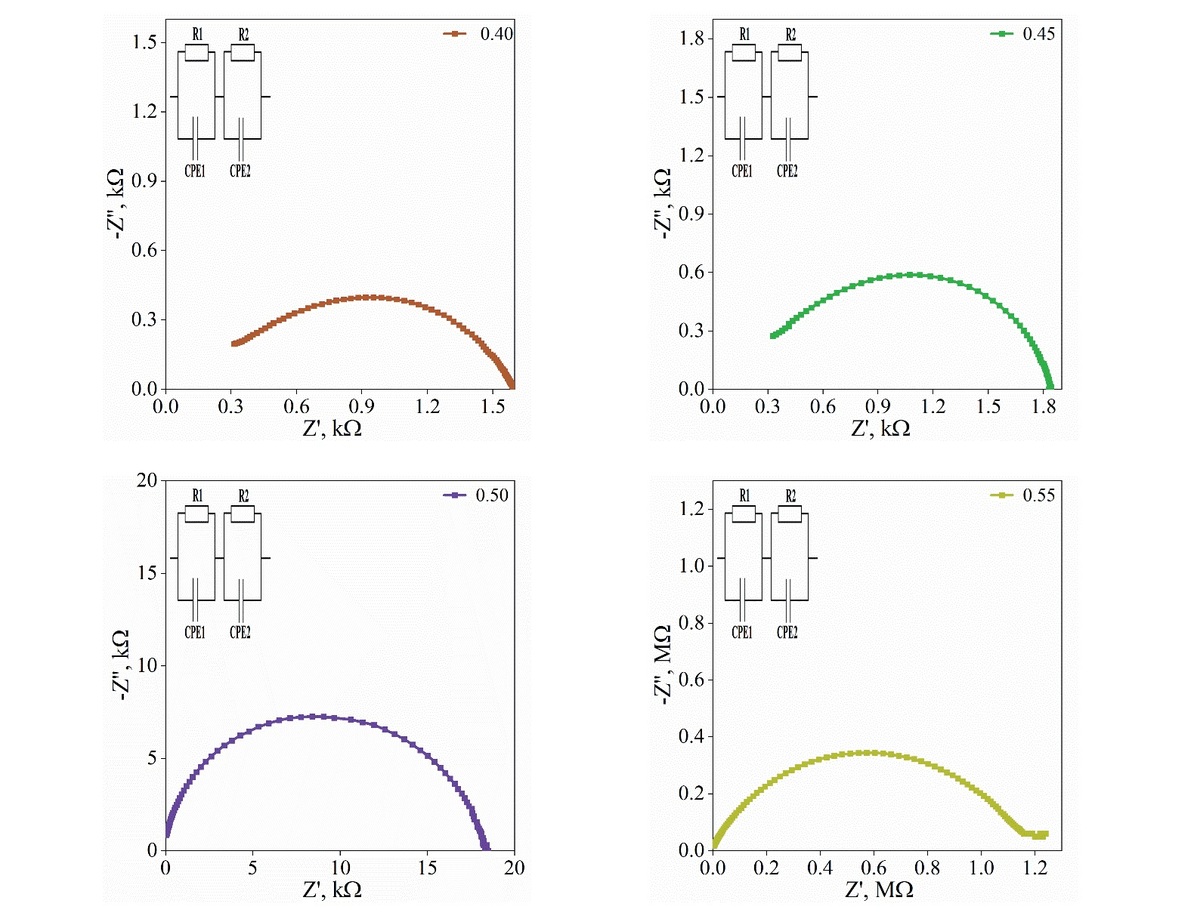Influence of water-cement ratio on electrical properties of smart cement composites
1
Department of Building Materials Technology, Faculty of Materials Science and Ceramics, AGH University of Krakow, al. Mickiewicza 30, 30-059 Krakow, Poland
2
Faculty of Space Technologies, AGH University of Krakow, al. Mickiewicza 30, 30-059 Krakow, Poland
Submission date: 2025-07-10
Final revision date: 2025-09-10
Acceptance date: 2025-09-28
Publication date: 2025-09-29
Cement Wapno Beton 30(1) 57-74 (2025)
KEYWORDS
TOPICS
ABSTRACT
This study presents the results of research on the influence of the water-to-cement ratio [w/c] on the electrical properties of cement composites with expanded graphite [EG]. The analysis was conducted on samples containing 2 % to 6 % EG, with w/c ratios
ranging from 0.40 to 0.60. The experimental program included four-point probe resistivity measurements, impedance spectroscopy, as well as evaluation of the thermoelectric and self-heating properties of the composites. The results indicate that increasing the w/c ratio leads to a reduction in the electrical conductivity of the studied composites, regardless of the EG content. Impedance spectra analysis showed that, within the investigated w/c range, the percolation threshold is exceeded in composites containing more than 4 % EG. The higher the EG content, percolation threshold is exceeded at higher w/c. An important observation is weakly formed semicircles in Nyquist plot for composites in the percolation zone. The closer conductivity of the composite is to the percolation threshold, the less distinct the semicircle. This characteristic spectrum shape allows for the determination of the conductive additive content in the percolation zone. Furthermore, the findings confirm that the w/c ratio significantly influences the self-heating properties of the investigated cement composites. In contrast, the w/c ratio does not appear to affect the magnitude of the Seebeck coefficient above the percolation threshold. The obtained results clearly indicate the significant role of water-to-cement ratio in shaping the functional properties of these materials.
REFERENCES (47)
1.
A. Sassani, A. Arabzadeh, H. Ceylan, S. Kim, S.M.S. Sadati, K. Gopalakrishnan, P.C. Taylor, H. Abdualla, Carbon fiber-based electrically conductive concrete for salt-free deicing of pavements. J. Clean. Prod. 203, 799–809 (2018). https://doi.org/10.1016/j.jcle....
2.
A.G. Mohammed, G. Ozgur, E. Sevkat, Electrical resistance heating for deicing and snow melting applications: Experimental study. Cold Reg. Sci. Technol. 160, 128–138 (2019). https://doi.org/10.1016/j.cold....
3.
R. Rao, J. Fu, Y. Chan, C.Y. Tuan, C. Liu, Steel fiber confined graphite concrete for pavement deicing. Compos. B 155, 187–196 (2018). https://doi.org/10.1016/j.comp....
4.
S. Mingqing, M. Xinying, W. Xiaoying, H. Zuofu, L. Zhuoqiu, Experimental studies on the indoor electrical floor heating system with carbon black mortar slabs. Energy Build. 40, 1094–1100 (2008). https://doi.org/10.1016/j.enbu....
5.
M. Hambach, H. Möller, T. Neumann, D. Volkmer, Carbon fibre reinforced cement-based composites as smart floor heating materials. Compos. B 90, 465–470 (2016). https://doi.org/10.1016/j.comp....
6.
M.S. Konsta-Gdoutos, C.A. Aza, Self sensing carbon nanotube (CNT) and nanofiber (CNF) cementitious composites for real time damage assessment in smart structures. Cem. Concr. Compos. 53, 162–169 (2014). https://doi.org/10.1016/j.cemc....
7.
O. Galao, F.J. Baeza, E. Zornoza, P. Garces, Strain and damage sensing properties on multifunctional cement composites with CNF admixture. Cem. Concr. Compos. 46, 90–98 (2014). https://doi.org/10.1016/j.cemc....
8.
D.D.L. Chung, Carbon Fiber Reinforced Concrete for Traffic Monitoring and Weighing in Motion. Cem. Concr. Res. 29, 435–439 (1999).
9.
A. Monteiro, A. Loredo, P. Costa, M. Oeser, P. Cachim, A pressure-sensitive carbon black cement composite for traffic monitoring. Constr. Build. Mater. 154, 1079–1086 (2017). https://doi.org/10.1016/j.conb....
10.
S. Ghosh, S. Harish, K.A. Rocky, M. Ohtaki, B.B. Saha, Graphene enhanced thermoelectric properties of cement based composites for building energy harvesting. Energy Build. 202, 109419 (2019). https://doi.org/10.1016/j.enbu....
11.
W. Pichór, M. Frąc, Multifunctional cement composites with expanded graphite for temperature monitoring of buildings. Adv. Cem. Res. 32, 413–420 (2020). https://doi.org/10.1680/jadcr.....
12.
E. Demircilioglu, E. Teomete, O.E. Ozbulut, Strain sensitivity of steel-fiber-reinforced industrial smart concrete. J. Intell. Mater. Syst. Struct. 31, 127–136 (2020). https://doi.org/10.1177/104538....
13.
S. Sun, B. Han, S. Jiang, X. Yu, Y. Wang, H. Li, J. Ou, Nano graphite platelets-enabled piezoresistive cementitious composites for structural health monitoring. Constr. Build. Mater. 136, 314–328 (2017). https://doi.org/10.1016/j.conb....
14.
B. Moral, F.J. Baeza, R. Navarro, O. Galao, E. Zornoza, J. Vera, C. Farcas, P. Garces, Temperature and humidity influence on the strain sensing performance of hybrid carbon nanotubes and graphite cement composites. Constr. Build. Mater. 284, 122786 (2021). https://doi.org/10.1016/j.conb....
15.
J. Zhang, A. Heath, H. Taha, R. Ball, K. Paine, Electrical impedance behaviour of carbon fibre reinforced cement-based sensors at different moisture contents. Constr. Build. Mater. 353, 129049 (2022). https://doi.org/10.1016/j.conb....
16.
M. Frąc, P. Szołdra, E. Teomete, W. Pichór, Effect of internal moisture on the electric conductivity of cement composites with expanded graphite determined by impedance spectroscopy. Cem. Concr. Compos. 151, 105610 (2024). https://doi.org/10.1016/j.cemc....
17.
W.J. McCarter, S. Garvin, Dependence of electrical impedance of cement-based materials on their moisture condition. J. Phys. D 22, 1773–1776 (1989). https://doi.org/10.1088/0022-3....
18.
T. Honorio, H. Carasek, O. Cascudo, Electrical properties of cement-based materials: Multiscale behavior and quantification of the variability. Constr. Build. Mater. 245, 118461 (2020). https://doi.org/10.1016/j.conb....
19.
Z. Liu, Y. Zhang, L. Liu, Q. Jiang, An analytical model for determining the relative electrical resistivity of cement paste and C–S–H gel. Constr. Build. Mater. 48, 647–655 (2013). https://doi.org/10.1016/j.conb....
20.
S. Cleven, M. Raupach, T. Matschei, Electrical resistivity of steel fibre-reinforced concrete—Influencing parameters. Materials 14, 3408 (2021).
21.
B. Chen, K. Wu, W. Yao, Conductivity of carbon fiber reinforced cement-based composites. Cem. Concr. Compos. 26, 291–297 (2004). https://doi.org/10.1016/S0958-....
22.
X. Dong, B. Han, J. Ou, Z. Li, L. Han, X. Yu, Electrically conductive behaviors and mechanisms of short-cut super-fine stainless wire reinforced reactive powder concrete. Cem. Concr. Compos. 72, 48–65 (2016). https://doi.org/10.1016/j.cemc....
23.
M. Bortoletto, A.O. Sanches, J.A. Santos, R.G. da Silva, M.M. Tashima, J. Payá, L. Soriano, M.V. Borrachero, J.A. Malmonge, J.L. Akasaki, New insights on understanding the Portland cement hydration using electrical impedance spectroscopy. Constr. Build. Mater. 407, 133566 (2023). https://doi.org/10.1016/j.conb....
24.
P. Azarsa, R. Gupta, Electrical resistivity of concrete for durability evaluation: A review. Adv. Mater. Sci. Eng. 2017, 8453095 (2017). https://doi.org/10.1155/2017/8....
25.
G.E. Monfore, The electrical resistivity of concrete. J. PCA Res. Dev. Lab. (1968).
26.
M. Adresi, F. Pakhirehzan, Evaluating the performance of self-sensing concrete sensors under temperature and moisture variations – a review. Constr. Build. Mater. 404, 132923 (2023). https://doi.org/10.1016/j.conb....
27.
G.M. Kim, F. Naeem, H.K. Kim, H.K. Lee, Heating and heat-dependent mechanical characteristics of CNT-embedded cementitious composites. Compos. Struct. 136, 162–170 (2016). https://doi.org/10.1016/j.comp....
28.
H.K. Kim, I.S. Park, H.K. Lee, Improved piezoresistive sensitivity and stability of CNT/cement mortar composites with low water–binder ratio. Compos. Struct. 116, 713–719 (2014). https://doi.org/10.1016/j.comp....
29.
N. Roussel, Rheological requirements for printable concretes. Cem. Concr. Res. 112, 76–85 (2018). https://doi.org/10.1016/j.cemc....
30.
G.M. Kim, S.M. Park, G.U. Ryu, H.K. Lee, Electrical characteristics of hierarchical conductive pathways in cementitious composites incorporating CNT and carbon fiber. Cem. Concr. Compos. 82, 165–175 (2017). https://doi.org/10.1016/j.cemc....
31.
S. Cleven, M. Raupach, T. Matschei, Electrical resistivity of steel fibre-reinforced concrete—Influencing parameters. Materials 14, 3408 (2021). https://doi.org/10.3390/ma1412....
32.
H.M. Park, G.M. Kim, S.Y. Lee, H. Jeon, S.Y. Kim, M. Kim, J.W. Kim, Y.C. Jung, B.J. Yang, Electrical resistivity reduction with pitch-based carbon fiber into multi-walled carbon nanotube (MWCNT)-embedded cement composites. Constr. Build. Mater. 165, 484–493 (2018). https://doi.org/10.1016/j.conb....
33.
M. Sun, Z. Li, Q. Mao, D. Shen, Study on the hole conduction phenomenon in carbon fiber-reinforced cement. Cem. Concr. Res. 28, 549–554 (1998). https://doi.org/10.1016/S0008-....
34.
Z. Zhou, N. Xie, X. Cheng, L. Feng, S. Huang, Z. Zhou, Electrical properties of low dosage carbon nanofiber/cement composite: Percolation behavior and polarization effect. Cem. Concr. Compos. 109, 103539 (2020). https://doi.org/10.1016/j.cemc....
35.
S. Wen, D. Chung, The role of electronic and ionic conduction in the electrical conductivity of carbon fiber reinforced cement. Carbon 44, 2130–2138 (2006). https://doi.org/10.1016/j.carb....
36.
W. Pichór, M. Frąc, M. Radecka, Determination of percolation threshold in cement composites with expanded graphite by impedance spectroscopy. Cem. Concr. Compos. 125, 104328 (2022). https://doi.org/10.1016/j.cemc....
37.
I. Balberg, Tunnelling and percolation in lattices and the continuum. J. Phys. D Appl. Phys. 42, 064003 (2009). https://doi.org/10.1088/0022-3....
38.
B. Díaz, B. Guitián, X.R. Nóvoa, C. Pérez, Conductivity assessment of multifunctional cement pastes by impedance spectroscopy. Corros. Sci. 185, 109441 (2021). https://doi.org/10.1016/j.cors....
39.
D.A. Triana-Camacho, D.A. Miranda, E. García-Macías, O.A. Mendoza Reales, J.H. Quintero-Orozco, Effective medium electrical response model of carbon nanotubes cement-based composites. Constr. Build. Mater. 344, 128293 (2022). https://doi.org/10.1016/j.conb....
40.
P.A. Danoglidis, M.S. Konsta-Gdoutos, S.P. Shah, Relationship between the carbon nanotube dispersion state, electrochemical impedance and capacitance and mechanical properties of percolative nanoreinforced OPC mortars. Carbon 145, 218–228 (2019). https://doi.org/10.1016/j.carb....
41.
M. Frąc, W. Pichór, Piezoresistive properties of cement composites with expanded graphite. Compos. Commun. 19, 99–102 (2020). https://doi.org/10.1016/j.coco....
42.
M. Frąc, W. Pichór, P. Szołdra, Cement composites with expanded graphite as resistance heating elements. J. Compos. Mater. 54, 3821–3831 (2020). https://doi.org/10.1177/002199....
43.
S. Wansom, N.J. Kidner, L.Y. Woo, T.O. Mason, AC-impedance response of multi-walled carbon nanotube/cement composites. Cem. Concr. Compos. 28, 509–519 (2006). https://doi.org/10.1016/j.cemc....
44.
X. Hu, C. Shi, X. Liu, J. Zhang, G. de Schutter, A review on microstructural characterization of cement-based materials by AC impedance spectroscopy. Cem. Concr. Compos. 100, 1–14 (2019). https://doi.org/10.1016/j.cemc....
45.
C.H. Hsu, F. Mansfeld, Technical Note: Concerning the conversion of the constant phase element parameter Y into a capacitance. Corrosion 57, 747–748 (2001). https://doi.org/10.5006/1.3280....
46.
Y.-J. Wang, Y. Pan, X.-W. Zhang, K. Tan, Impedance spectra of carbon black filled high-density polyethylene composites. J. Appl. Polym. Sci. 98, 1344–1350 (2005). https://doi.org/10.1002/app.22....
47.
M. Radecka, E. Pamula, A. Trenczek-Zajac, K. Zakrzewska, A. Brudnik, E. Kusior, N.-T.H. Kim-Ngan, A.G. Balogh, Chemical composition, crystallographic structure and impedance spectroscopy of titanium oxynitride TiNxOy thin films. Solid State Ionics 192, 693–698 (2011). https://doi.org/10.1016/j.ssi.....
Share
RELATED ARTICLE
We process personal data collected when visiting the website. The function of obtaining information about users and their behavior is carried out by voluntarily entered information in forms and saving cookies in end devices. Data, including cookies, are used to provide services, improve the user experience and to analyze the traffic in accordance with the Privacy policy. Data are also collected and processed by Google Analytics tool (more).
You can change cookies settings in your browser. Restricted use of cookies in the browser configuration may affect some functionalities of the website.
You can change cookies settings in your browser. Restricted use of cookies in the browser configuration may affect some functionalities of the website.




